
Scilla is a genus of about 30 to 80 species of bulb-forming perennial herbaceous plants in the family Asparagaceae, subfamily Scilloideae. Sometimes called the squills in English, they are native to woodlands, subalpine meadows, and seashores throughout Europe, Africa and the Middle East. A few species are also naturalized in Australasia and North America. Their flowers are usually blue, but white, pink, and purple types are known; most flower in early spring, but a few are autumn-flowering. Several Scilla species are valued as ornamental garden plants.

Scilloideae is a subfamily of bulbous plants within the family Asparagaceae. Scilloideae is sometimes treated as a separate family Hyacinthaceae, named after the genus Hyacinthus. Scilloideae or Hyacinthaceae include many familiar garden plants such as Hyacinthus (hyacinths), Hyacinthoides (bluebells), Muscari and Scilla and Puschkinia. Some are important as cut flowers.

Ornithogalum is a genus of perennial plants mostly native to southern Europe and southern Africa belonging to the family Asparagaceae. Some species are native to other areas such as the Caucasus. Growing from a bulb, species have linear basal leaves and a slender stalk, up to 30 cm tall, bearing clusters of typically white star-shaped flowers, often striped with green. The common name of the genus, star-of-Bethlehem, is based on its star-shaped flowers, after the Star of Bethlehem that appears in the biblical account of the birth of Jesus. The number of species has varied considerably, depending on authority, from 50 to 300.

Hyacinthoides is a genus of flowering plants in the family Asparagaceae, known as bluebells.
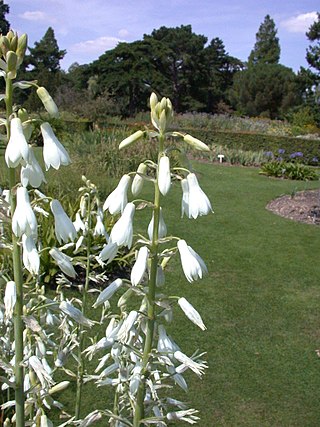
Galtonia is a genus of plants in the family Asparagaceae, subfamily Scilloideae. Native to Southern Africa, the genus is named after Sir Francis Galton. According to some authorities it has been subsumed into Ornithogalum as a subgenus, while others prefer to keep it as a separate genus.
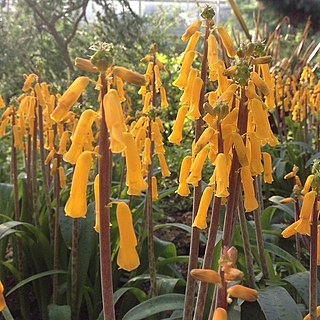
Lachenalia is a genus of bulbous perennial plants in the family Asparagaceae, subfamily Scilloideae, which are usually found in Namibia and South Africa. Most of them have a dormancy period, but new roots will always grow every year.

Scilla section Chionodoxa, known as glory-of-the-snow, is a small group of bulbous perennial flowering plants in the family Asparagaceae, subfamily Scilloideae. Formerly treated as the separate genus Chionodoxa, they are now included in Scilla as a section. The section is endemic to the eastern Mediterranean, specifically Crete, Cyprus and Turkey. The blue, white or pink flowers appear early in the year making them valuable garden ornamentals. The common name of the group is based on the habit of flowering in high alpine zones when the snow melts in spring.
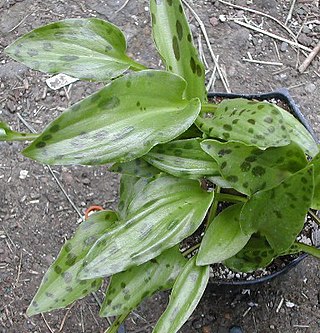
Drimiopsis is a genus of African bulbous perennial herbs in the family Asparagaceae, subfamily Scilloideae, native to sub-Saharan Africa. Sometimes species are placed under the genus Ledebouria.

Albuca is a genus of flowering plants in the family Asparagaceae, subfamily Scilloideae. The genus is distributed mainly in southern and eastern Africa, with some species occurring in northern Africa and the Arabian Peninsula. Plants of the genus are known commonly as slime lilies.

Drimia is a genus of flowering plants. In the APG IV classification system, it is placed in the family Asparagaceae, subfamily Scilloideae. When broadly circumscribed, the genus includes a number of other genera previously treated separately, including Litanthus, Rhodocodon, Schizobasis and Urginea.
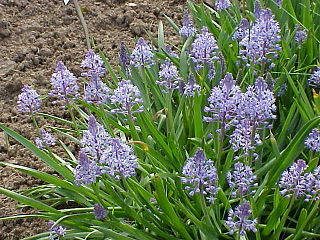
Scilla litardierei, the amethyst meadow squill or Dalmatian scilla, is a species of flowering plant in the family Asparagaceae. A bulbous perennial, with blue grape-hyacinth like flowers, blooming in late spring, much later than the more popular Siberian squill and later than Muscari which it resembles.

Barnardia is a small genus of bulbous flowering plants in the family Asparagaceae, subfamily Scilloideae. The genus has two species, one found in the Balearic Islands and north-west Africa, the other in east China, Korea, Japan and adjacent localities. It was suggested in 2012 that the two species were not closely related.

Merwilla is a genus of bulbous flowering plants in the family Asparagaceae, subfamily Scilloideae. It is distributed in southern Africa, from Zimbabwe to South Africa. This genus is named after the botanist Frederick Ziervogel Van der Merwe (1894–1968), who worked on this group.
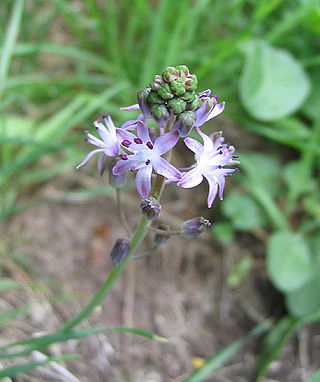
Prospero is a genus of bulbous flowering plants in the family Asparagaceae, subfamily Scilloideae. It is distributed in Europe, around the Mediterranean, and through the Middle East to the Caucasus.
Pseudoprospero is a genus of bulbous flowering plants in the family Asparagaceae, subfamily Scilloideae. The genus has a single species Pseudoprospero firmifolium, which is endemic to South Africa.

Spetaea is a monotypic genus of bulbous flowering plants in the family Asparagaceae, subfamily Scilloideae. The only known species Spetaea lachenaliiflora is found only in the south-west of the Cape Province in South Africa. Prior to 2003, it was incorrectly known as Scilla plumbea.
Ledebouria ovalifolia is a species of bulbous flowering plant in the family Asparagaceae, native to the Cape Provinces of South Africa.
















